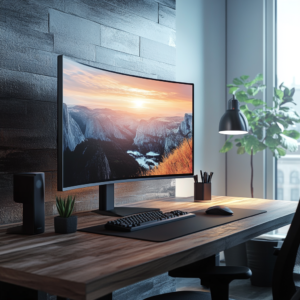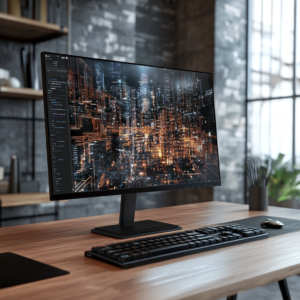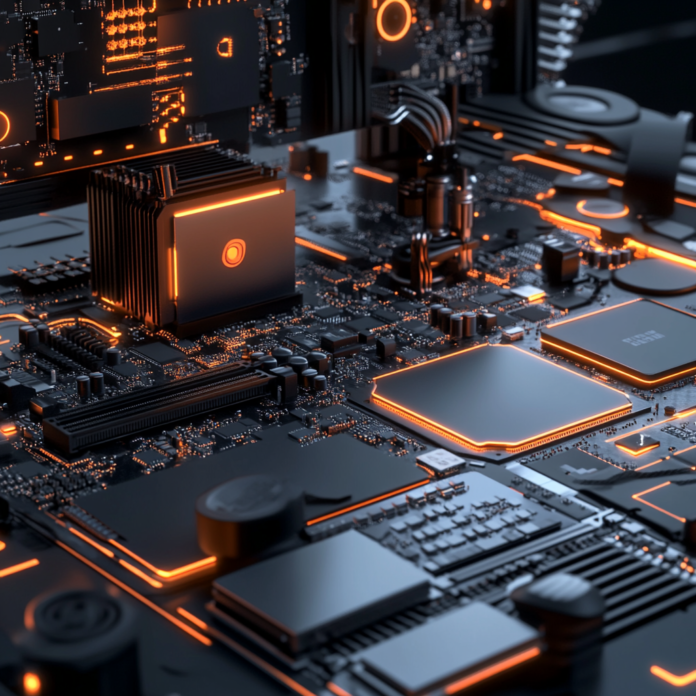1. Introduction
How to Upgrade Your tech setup on a budget is a challenge many of us face in today’s rapidly evolving digital world. In this article, I share my personal experiences and comprehensive research on cost-effective methods to revamp your technology without breaking the bank. I will discuss strategies ranging from simple software tweaks to major hardware upgrades. Whether you are a student, a professional, or simply a tech enthusiast, you’ll find actionable advice to transform your current system into one that meets modern demands. Along the way, I include internal links to valuable resources on VikingBytes.com—such as our Budget PC Buying Guide and Emerging Trends in Computer Hardware for 2025—so you can explore additional details.

2. Why and When to Upgrade Your Tech Setup
Deciding how to upgrade your tech setup on a budget starts with understanding why an upgrade is necessary. How to Upgrade Your devices might be driven by slowing performance, outdated components, or the need for new features that enhance productivity. I realized that my own system started lagging behind after several years, making multitasking difficult. It’s essential to evaluate whether your current hardware meets your professional and personal needs. Look for signs like extended load times, system crashes, or frequent software updates that your current device struggles to handle. Upgrading can be done incrementally, which means you can replace components one at a time, reducing the overall expense. This method allows you to spread out the costs while continuously improving performance. For more insights on when to upgrade, check our Emerging Trends in Computer Hardware for 2025 article.
3. Assessing Your Current Setup
Before planning any upgrades, assess your current tech setup thoroughly. How to Upgrade Your system effectively begins with a clear understanding of its strengths and weaknesses. Start by reviewing the specifications of your computer: CPU speed, RAM capacity, storage type, graphics capabilities, and peripheral conditions. Utilize benchmarking tools such as Geekbench or Cinebench, and read user reviews on platforms like PCMag. Document which components are causing performance bottlenecks. This self-assessment is crucial because it helps prioritize which parts need an immediate upgrade and which can wait. A well-documented analysis of your current setup ensures that you make informed decisions and invest in the most impactful improvements.
4. Setting a Realistic Budget
How to Upgrade Your tech setup on a budget requires setting a clear and realistic budget from the start. Determine how much you are willing to invest without compromising your financial stability. Remember that you can upgrade incrementally, which means you don’t have to replace your entire system at once. Allocate funds based on your priorities—if performance is critical for your work, investing more in CPU or GPU upgrades might be essential. There are plenty of online tools to help you compare prices, and websites like Newegg or Amazon offer competitive deals. Keeping a detailed budget plan helps avoid overspending and ensures that you maximize every dollar invested in upgrading your tech setup.
5. Prioritizing Upgrades
When working with limited funds, it’s important to prioritize which components will have the most significant impact. How to Upgrade Your setup on a budget means focusing on the areas that yield immediate performance gains. For instance, if your computer is slow during multitasking, upgrading the RAM may be a cost-effective solution. If your storage is old and slow, consider replacing your HDD with an SSD. Other areas, like peripheral improvements or software optimization, can often be addressed later. By establishing clear priorities, you ensure that every dollar spent enhances your overall system performance. Prioritization is the cornerstone of a successful upgrade strategy, and I always recommend starting with what will immediately improve your day-to-day tasks.
6. Upgrading Hardware Components
Hardware upgrades are the most direct way to improve your tech setup. How to Upgrade Your computer on a budget involves careful research and smart buying decisions. Here, I break down several key components to consider.
6.1 CPU and Motherboard Upgrades
Upgrading your processor can significantly boost performance, particularly for multitasking and resource-intensive applications. However, a new CPU may require a compatible motherboard. Look for models that offer the best performance within your budget. Websites like Tom’s Hardware provide reviews and compatibility guides. Investing in a new CPU and motherboard together can future-proof your system and enable further upgrades later on. Always check for deals and promotions to get the best prices.
6.2 Memory (RAM) Improvements
Increasing your RAM is one of the easiest and most affordable upgrades. More memory allows your computer to handle more tasks simultaneously without slowing down. For most users, upgrading to 16GB is a great balance between cost and performance, though gamers and professionals may benefit from 32GB or more. Consider using reputable brands and ensure that the RAM is compatible with your motherboard. This upgrade is a key part of how to Upgrade Your tech setup on a budget and can often be installed without professional help.
6.3 Storage: SSDs vs. HDDs
Replacing an old hard drive with a solid-state drive (SSD) is one of the most transformative upgrades you can perform. SSDs offer faster boot times, quicker file transfers, and more responsive performance overall. While SSDs can be more expensive than HDDs, the performance boost is well worth the investment. For additional savings, consider hybrid drives or even external SSDs if budget constraints are tight. Online retailers like Newegg often have seasonal discounts on storage solutions that can help you upgrade your system without overspending.
7. Enhancing Graphics and Display
The visual aspect of your tech setup is crucial for both work and entertainment. How to Upgrade Your display setup on a budget includes considering external monitors, graphic cards, and even cable quality. For gamers and creative professionals, a high-quality monitor with accurate color reproduction and high resolution is essential. If your system supports it, upgrading your GPU can provide smoother visuals and enhanced performance in graphics-intensive applications. Research sites like AnandTech for the latest benchmarks on graphics cards and monitors. Balancing your display upgrades with other hardware improvements ensures a cohesive system that performs well under all conditions.
8. Optimizing Peripherals
Peripheral devices, though sometimes overlooked, can dramatically enhance your overall tech setup. How to Upgrade Your workstation with quality peripherals on a budget involves investing in ergonomic and efficient devices that support your workflow.
8.1 Monitors, Keyboards, and Mice
An external monitor expands your screen real estate, which is invaluable for multitasking and creative work. Ergonomic keyboards and responsive mice not only reduce physical strain but also significantly boost productivity. For those interested in optimizing their work environment even further, I recommend checking out our detailed guide on Office Ergonomics Essentials. Please verify if this link is working properly on your end.
8.2 Audio Solutions and Other Accessories
High-quality speakers or noise-canceling headsets are crucial for clear audio during video calls and multimedia tasks. Additionally, accessories such as external webcams, cable organizers, and docking stations further streamline your workspace. These peripherals not only enhance productivity but also complement the overall aesthetic of your setup. I often recommend checking reviews on TechRadar for the latest models and ensuring compatibility with your existing devices.

9. Upgrading Connectivity and Networking
Reliable connectivity is the backbone of any modern tech setup. How to Upgrade Your network on a budget involves investing in quality routers, range extenders, or even a mesh Wi-Fi system. A strong, stable connection is critical for streaming, online gaming, and cloud-based work. Routers with advanced features like dual-band or tri-band support ensure that your entire setup can operate smoothly even when multiple devices are connected simultaneously. External sources such as CNET provide in-depth reviews of networking hardware to help you choose the best option within your budget. Integrating these improvements can drastically enhance your online experience.
10. Software Optimization and System Maintenance
Upgrading your tech setup isn’t only about hardware; software optimization plays a critical role too. How to Upgrade Your system software on a budget includes regular updates to your operating system, drivers, and essential applications. Removing bloatware and performing periodic system clean-ups can improve speed and efficiency. Tools like CCleaner or Windows built-in optimization features are useful. Additionally, investing in premium software—such as productivity suites or advanced editing tools—can further refine your workflow. Check out reviews on PCMag for recommendations on software upgrades that provide excellent performance without a steep cost.
11. Energy Efficiency and Cost Savings
A well-optimized tech setup not only performs better but also consumes less energy. How to Upgrade Your tech setup on a budget with energy-efficient solutions includes choosing components with lower power consumption and enabling power-saving modes on your devices. Modern CPUs and GPUs come with energy-efficient architectures that maintain performance while reducing electricity usage. Investing in smart power strips and energy monitors can also help you track usage and cut down on wasted power. This approach not only saves money but also contributes to a greener environment, aligning with long-term cost-saving strategies.
12. DIY vs. Professional Upgrades
When planning upgrades, you need to decide whether to tackle the project yourself or seek professional help. How to Upgrade Your system on a budget can often be done DIY, especially if you have basic technical skills. There are countless online tutorials and video guides on platforms like YouTube that walk you through upgrades step-by-step. However, if you’re uncomfortable opening your computer or dealing with sensitive components, professional services might be a safer bet. Websites like iFixit offer comprehensive repair guides and tools that empower you to do it yourself, potentially saving money in the process.
13. Real-World Examples and Case Studies
Real-life case studies are invaluable when learning how to upgrade your tech setup on a budget. I recall upgrading my own computer by starting with an SSD replacement, which dramatically improved boot times and responsiveness. In another instance, I added more RAM to handle heavy multitasking, leading to smoother performance during video editing sessions. Many users share their experiences on forums like Reddit’s r/buildapc and Linus Tech Tips forums, where they discuss challenges, tips, and success stories. These firsthand accounts help illustrate how small upgrades can cumulatively transform your system. They also reveal that even modest investments can yield significant improvements in performance.
14. Expert Recommendations and Resources
Expert advice can be a game-changer when planning upgrades. How to Upgrade Your tech setup on a budget is often guided by recommendations from tech experts. Publications such as Tom’s Hardware, TechRadar, and PCMag offer detailed reviews and benchmarks. I personally rely on these resources to identify which components are worth the investment and which can be skipped. Additionally, many experts suggest prioritizing upgrades that provide the best performance-to-cost ratio. For instance, increasing RAM or switching to an SSD frequently ranks high on the list of effective improvements. These insights are invaluable in shaping an upgrade strategy that balances performance with affordability.
15. Frequently Asked Questions (FAQ)
Q1: What is the first step in upgrading my tech setup on a budget?
A1: Begin by assessing your current setup and identifying performance bottlenecks. Determine whether your primary issues are due to slow processing, insufficient memory, or outdated storage. This analysis helps you prioritize which upgrades will yield the most significant improvements.
Q2: Can I upgrade my tech setup without professional help?
A2: Yes, many upgrades such as installing RAM, replacing an HDD with an SSD, or updating drivers can be performed DIY. Online guides and tutorials on sites like iFixit can assist you in these endeavors.
Q3: How do I know if a component upgrade is worth the cost?
A3: Look for reviews, benchmarks, and real-world performance tests on reputable sites like Tom’s Hardware. Compare the price-to-performance improvements reported by experts and users.
Q4: What upgrades offer the most noticeable performance boost?
A4: Upgrading from an HDD to an SSD and increasing RAM are often the most impactful improvements for everyday tasks and multitasking. These changes can reduce boot times and improve overall responsiveness significantly.
Q5: Where can I find deals on components?
A5: Online retailers such as Newegg and Amazon frequently offer discounts and bundles. Additionally, tech forums and deal sites like Slickdeals often share promotions on hardware upgrades.
16. Call to Action – Affiliate Offers
For more reliable stabilization, check out our recommended product.
This tool has helped me a lot in creating the right prompts to generate amazing images. Check out the best AI for creating images and videos here.
17. Additional Insights on Upgrading Tech Setups
17.1 Market Trends and Future Innovations
Data from Statista shows a steady rise in consumer demand for efficient, budget-friendly tech upgrades. As new technologies emerge, manufacturers are offering improved components at lower costs, making it easier than ever to keep your system current. Innovations like NVMe SSDs, next-generation processors, and energy-efficient GPUs are continually changing the landscape. Keeping an eye on these trends is crucial for understanding how to Upgrade Your tech setup on a budget and ensuring that your system remains competitive.
17.2 How DIY Upgrades Evolve
The DIY approach to upgrading technology has evolved remarkably. Online communities, comprehensive guides, and video tutorials on platforms like YouTube provide step-by-step instructions that empower users to tackle upgrades on their own. This trend has made it accessible for anyone to learn how to Upgrade Your tech setup on a budget, saving money and gaining valuable skills in the process. I have personally benefited from these resources, which have enabled me to upgrade components safely and efficiently.

18. Maintenance and Upgrades for Your Tech Setup
18.1 Regular Maintenance and Best Practices
Regular maintenance is essential to keep your system running smoothly after an upgrade. Cleaning dust from components, updating firmware, and performing routine software optimizations are crucial practices. I recommend setting a monthly schedule to check your system’s health. This proactive approach ensures that your newly upgraded tech setup remains efficient and prolongs its lifespan. Consistent maintenance not only maximizes performance but also minimizes unexpected downtime, helping you get the most out of your investment in How to Upgrade Your tech setup on a budget.
18.2 When and How to Upgrade Your Components
Knowing when to upgrade is as important as the upgrade itself. If you notice your system lagging during routine tasks or struggling with new software demands, it might be time to consider a hardware refresh. Upgrading your RAM, storage, or even your GPU can lead to immediate improvements in performance. Research extensively before making a decision, and consult expert reviews on sites like PCMag to determine the best products available. A thoughtful upgrade strategy can transform an aging system into a robust machine without the high cost of a complete overhaul.
19. Conclusion and Final Remarks
How to Upgrade Your tech setup on a budget is a journey that combines careful planning, smart purchasing decisions, and regular maintenance. Throughout this guide, I have shared insights into key components, provided detailed comparisons, and highlighted the importance of balancing performance with cost. Whether you’re upgrading for gaming, professional tasks, or everyday computing, each improvement contributes to a more efficient and responsive system. By following the strategies outlined here, you can ensure that your tech remains current, capable, and cost-effective. I hope this guide empowers you to confidently invest in the upgrades that best meet your needs, and that your final setup truly reflects the power of How to Upgrade Your tech setup on a budget. Happy upgrading!
